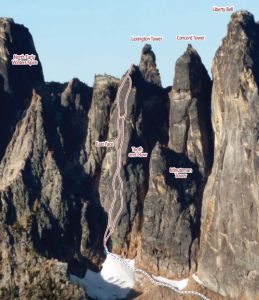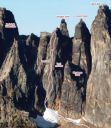East Face, Lexington Tower IV 5.9+ |
||
Washington Pass, Washington, USA | ||
| ||
|
Avg time to climb route: 3-7 hours
Approach time: 1.5-2.5 hours Descent time: 1.5-2.5 hours Number of pitches: 9 Height of route: 800' Overview
The East Face of Lexington Tower may not be the biggest of the Liberty Bell groupís east faces, but itís a full value experience that certainly packs a punch. While it may have an easier grade than many of the East Face routes, if you are unaccustomed to wide cracks, this route could feel like the one of the hardest. That said, those up to the challenge will be greeted by excellent, clean rock with amazing position, and sustained wide climbing not often found in Washington State. Climbing below the ominous roof is alluring and the traverse around its right side is spectacular.
Photos
- View all 2 photos of East Face as: Thumbnails | Slideshow
Climber Beta on East Face
Find other routes like
East Face
Route History
The East Face of Lexington Tower was first climbed in 1966 by Steve Marts and Don McPherson. This was pre-highway and the pair faced a long hike in up Early Winters Creek. With no road and few people around, the towering east faces were an extremely bold and committing undertaking. But the pairís experience in the area and their recent first ascent of Liberty Crack gave them confidence.The climbing started off easy enough though protection was scarce, the route finding unobvious and the impossible- looking roof loamed over them. Once they reached the roof, Marts and McPherson were relieved to find they could traverse to the right and avoid the incredibly difficult looking Bombay Chimney above. After a tough section requiring a mix of aid and free climbing, McPherson aided off a hook. With no protection below for quite a distance and no possibilities for anchors in sight, he wedged himself into the crack. Not wanting to waste time, he began shouting at Marts to start jumaring. McPherson started drilling while Marts jumared on McPhersonís body; keep in mind, this was in the days of the swami belt. It was an intense moment. McPherson recalls, ďI was taking a chance on both of us,Ē but he didnít want to slow down. After that, one more challenging pitch led to easier climbing. They finished their route without losing their rack, and claimed another classic First Ascent on another of the great east faces. Strategy
The East Face of Lexington Tower is a big route for solid 5.9 climbers with wide crack experience. Because of the East Faceís formidable reputation, crowds are light and more than one other party is unlikely even on a busy weekend. Passing is difficult. There are no variations after Pitch 1, and the stances are small at nearly all of the belay ledges.Start early. While the first few pitches are easier with generally sound rock, they have some huge runouts (40-50 feet) and route finding is not always obvious. Once you gain the corner below the massive, ominous roof, the route finding is straightforward, while the climbing becomes progressively more difficult. Lead bolts have been added to the crux pitch, but due to the wide nature of the climbing the pitches are slightly runout, especially in the chimney above the crux wide section. You canít aid through most cruxes on gear. Pitch 4 is spectacular with splitter jamming in a corner, and while Pitch 5 appears incredibly ominous, the climbing is easier than it looks as you can traverse around the right side of the roof instead of being forced to climb straight through it. Pitch 6 is the crux. You arenít going to take a very big fall, but you canít pull through it on gear because the crack is too wide. Just chicken wing, arm bar and thrutch your way up. The pitch eases after you pull into a physical but secure chimney where you have up to 20-foot runouts between placements. The remaining pitches are sustained but not nearly as difficult. You can link Pitches 6 and 7 to avoid a poor belay stance, but itís a rope stretcher, and rope drag must be managed appropriately. The East Face route doesnít top out on the true summit of Lexington Tower. While it is sad to not top out on a mountain, this route is the exception. The summit is less than 100 feet away, but the rock is horrible. Parties that want to top out can hike around and climb up the North face (II 5.7), but most will call it good at the notch and descend. Expect to carry all you gear up and over the route because it is not practical to return to the base. Go as light as possible, having to chimney with too much gear makes the squeeze chimneys and offwidths even more difficult. Retreat Storm
There are no fixed anchors so retreat is involved, and expect to lose a lot of gear. You lose less gear with two 60m ropes.
Everything You Need to Know About
Washington Pass
Search the internet for beta on
East Face
|
Other Routes on Lexington Tower
|




